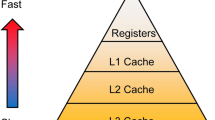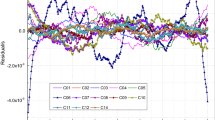Abstract
Global navigation satellite system (GNSS) ultra-rapid clock offsets and orbit products are essential for near-real-time and real-time uses. To meet the requirements of accuracy and timeliness in high-accuracy applications, the issuing rates of ultra-rapid products are increased to six or three hours. However, there is an appreciable fluctuation of positioning residuals during the period of updating of products. To improve the performance of GNSS rapid services including the GPS, GLONASS, GALILEO and BeiDou, this paper proposes a method for updating satellite ultra-rapid clock offsets and orbits based on the covariance intersection algorithm, where kernel tricks are used to model the series in the position domain. Moreover, the parameter characteristics of the clock and orbit and the unknown inter-series correlation are considered in the model of satellite ultra-rapid products. Meanwhile, a sparse strategy is used in solving the model coefficients; i.e., the least absolute shrinkage and selection operator (LASSO) strategy. Several experimental schemes show that 1) jumps and gross errors in the GNSS ultra-rapid clock offset affect the modeling and services and should be detected and repaired before high-accuracy applications; 2) the updating of clock offsets and orbits reduces the steadiness of product services, while position residual fluctuations are introduced using GNSS precise point positioning solutions; 3) improved clock offset and orbit series can be obtained using the covariance intersection algorithm and kernel tricks; 4) the LASSO strategy can automatically and effectively choose and estimate the model coefficients of clock offset and orbit series; and 5) the proposed method can smooth the short-term arcs of GNSS products and positioning services by 29.8–99.5% for Multi-GNSS Experiment stations compared with original series. It is thus concluded that the proposed updating strategy is meaningful for improving GNSS satellite ultra-rapid products.


















Similar content being viewed by others
References
Ai Q, Maciuk K, Lewinska P et al (2021) Characteristics of onefold clocks of GPS, Galileo. BeiDou GLONASS Syst Sensors 21(7):2396
Chang G, Qian N, Chen C et al (2020) Precise instantaneous velocimetry and accelerometry with a stand-alone GNSS receiver based on sparse kernel learning. Measurement 159:107803
Dow J, Neilan R, Rizos C (2009) The international GNSS service (IGS) in a changing landscape of global navigation satellite systems. J Geodesy 83(3–4):191–198
Dai X., Lou Y., Dai Z., et al. (2019) Precise orbit determination for GNSS maneuvering satellite with the constraint of a predicted clock. Remote Sensing 11(16):1949
Dai X (2016) Real-time precise GNSS satellite orbit determination using the SRIF method: theory and implementation. Wuhan University, Wuhan, China
Guo J (2014) The impacts of attitude, solar, radiation and function model on precise orbit determination for GNSS satellites. Wuhan University, Wuhan, China
Huang G, Cui B, Zhang Q et al (2018) An improved predicted model for BDS ultra-rapid satellite clock offsets. Remote Sensing 10(1):60
Hu C (2020) An investigation of key technologies related to combining BDS-2 and BDS-3 observations in data processing. China University of Mining and Technology, Xuzhou, China
Hu C, Wang Z, Rao P et al (2021) One-step correction strategy for BDS-2/BDS-3 satellite observation code bias and multipath delay. Acta Geod Geoph 56(1):29–59
He L, Ge M, Wang J et al (2013) Experimental study on the precise orbit determination of the BeiDou navigation satellite system. Sensors 13(3):2911–2928
Huang C, Song S, Chen Q (2019) Preliminary analysis of BDS-3 data based on iGMAS. Acta Astronom Sinica 60(02):52–63
Hauschild A (2010) Precise GNSS clock-estimation for real-time navigation and precise point positioning. Technische Universität München, Germany
Jia X (2019) Annual report of GNSS service performance monitoring and assessment (2018) Center of international GNSS Monitoring and Assessment (iGMAS), Xi'an, China
Jiao W (2020) International GNSS Monitoring and Assessment system (iGMAS) and its latest assessment results. In: The 11th China Satellite Navigation Conference (CSNC), Chengdu, China
Kouba J (2019) Relativity effects of Galileo passive hydrogen maser satellite clocks. GPS Solut 23:117
Li X, Ge M, Dai X et al (2015) Accuracy and reliability of multi-GNSS real-time precise positioning: GPS, GLONASS, BeiDou, and Galileo. J Geodesy 89(6):607–635
Li X, Zhu Y, Zheng K et al (2020) Precise orbit and clock products of Galileo, BDS and QZSS from MGEX Since 2018: comparison and PPP validation. Remote Sensing 12(9):1415
Li M (2011) Research on multi-GNSS precise orbit determination theory and application. Wuhan University, Wuhan, China
Lyu D, Zeng F, Ouyang X et al (2020) Real-time clock comparison and monitoring with multi-GNSS precise point positioning: GPS, GLONASS and Galileo. Adv Space Res 65(1):560–571
Mao Y, Wang Q, Hu C et al (2018) New clock offset prediction method for BeiDou satellites based on inter-satellite correlation. Acta Geod Geoph 54:35–54
Ruan R, Jia X, Zhu J et al (2020) Integrated orbit determination and time synchronization for BDS-3 satellites with satellite-ground and inter-satellite one-way Ka-pseudoranges. Acta Geodaeticaet Cartographica Sinica 49(3):292–299
Senior K, Ray J, Beard R (2008) Characterization of periodic variations in the GPS satellite clocks. GPS Solutions 12(3):211–225
Song X, Mao Y, Feng L et al (2017) The preliminary result and analysis for BD orbit determination with inter-satellite link data. Acta Geodaeticaet Cartographica Sinica 46(5):547–553
Shi C, Zheng F, Lou Y et al (2019) National BDS augmentation service system (NBASS) of China: progress and assessment. Remote Sensing 9(8):1–16
Su K, Jin S, Jiao G (2020) Assessment of multi-frequency GNSS PPP models using GPS Beidou GLONASS Galileo and QZSS. Measur Sci Technol 31:064008
Teunissen P, Montenbruck O (2017) Springer handbook of global navigation satellite systems. Springer
Tan B, Yuan Y, Zhang B et al (2016) A new analytical solar radiation pressure model for current BeiDou satellites: IGGBSPM. Sci Rep 6:32967
Wang Y, Lu Z, Qu Y et al (2017) Improving prediction performance of GPS satellite clock bias based on wavelet neural network. GPS Solutions 21(2):523–534
Wang F, Lin S, Gong X et al (2020) Decimeter-level orbit determination for FY3C satellite based on space-borne GPS/BDS measurements. Geomat Inf Sci Wuhan Univ 45(1):1–6
Xu L, Gao J, Li Z et al (2021) Denoising ionospheric observables based on multipath error modelling with Tikhonov regularization. Measur Sci Technol 32(2):025801
Yao Y, Yang Y, Sun H et al (2020) Geodesy discipline: progress and perspective. Acta Geodaeticaet Cartographica Sinica 49(10):1243–1251
Zheng Z, Dang Y, Lu X et al (2010) Study on GPS satellite clock bias prediction with IGS ultra-rapid ephemeris. Sci Survey Mapp 35(2):8–12
Zhao Q, Wang Q, Wang C et al (2017) Enhanced orbit determination for BeiDou satellites with FengYun-3C onboard GNSS data. GPS Solut 21:1179–1190
Zhao L, Dousa J, Ye S et al (2020) A flexible strategy for handling the datum and initial bias in real-time GNSS satellite clock estimation. J Geodesy 94(1):3
Acknowledgements
This work was supported by the Natural Science Foundation of Anhui Colleges (Grant No. KJ2020A0310); the National Key Research and Development Program of China (Grant No. 2020YFA0713502); the Anhui Natural Science Foundation (Grant No. 2108085QD173); the National Natural Science Foundation of China (Grant Nos. 41874039) and the Jiangsu Natural Science Foundation (Grant No. BK20181361). The authors thank the International GNSS Monitoring and Assessment Service (iGMAS) for the use of its data and products. We also wish to thank all the anonymous reviewers and editors for their helpful comments and suggestions for the improvement of this paper.
Author information
Authors and Affiliations
Contributions
Chao Hu conceived and designed the experiments; Zhongyuan Wang and Chao Hu performed the experiments, analyzed the data and wrote the paper; Chao Hu, Weicai Lv and Tong Cheng contributed to discussions and revisions.
Corresponding author
Ethics declarations
Conflict of interest
The authors declare that they have no conflict of interest.
Appendix
Appendix
We set two groups of observations as y1 and y2. The matrix expression is
where e1 and e2 are the model errors and F1 and F2 are the observation functions. The co-factor matrix is thus written as
The solution to x is obtained from Eqs. (19) and (20) as
where \({\hat{\mathbf{Q}}}_{xx}\) is expressed as
Moreover, we obtain the covariance of \({\hat{\mathbf{x}}}\) as
We can further modify Eq. (23) as
Rights and permissions
About this article
Cite this article
Hu, C., Wang, Z., Lv, W. et al. A method for updating GNSS satellite ultra-rapid clock offsets and orbits with the aid of a covariance intersection algorithm. Acta Geod Geophys 57, 63–84 (2022). https://doi.org/10.1007/s40328-022-00374-8
Received:
Accepted:
Published:
Issue Date:
DOI: https://doi.org/10.1007/s40328-022-00374-8




